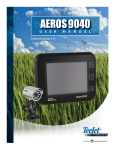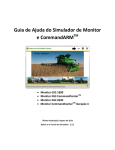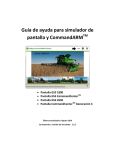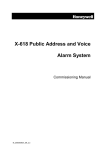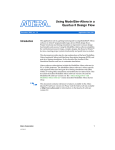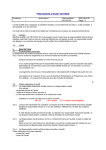Download APEXTM SOFTWARE USER GUIDE © Dr Ron Basu, Performance
Transcript
APEXTM SOFTWARE USER GUIDE © Dr Ron Basu, Performance Excellence Ltd, UK INTRODUCTION In the context of project and programme management ‘excellence’ connotes the achievement of a sustainable standard of success criteria. The purpose of project excellence is to enhance an organisation’s ability to implement project objectives through a successful, and consistent delivery of projects. There are many so called project excellence and maturity models in the market, such as EFQM based IPMA model, CMMI. OPM3 and P2MI to name a few. A recent review has concluded that although all the models have ‘improvement at their heart’, comparing models can be confusing and it is difficult to decide which model would be best fit for a particular purpose. Furthermore an on line questionnaire base survey for Project Managers in the UK showed that the use of project excellence and maturity models in project management was found to be at its infancy and only EFQM based excellence model and customised checklist were showing some application. Although it is recognised that these models form a useful part of achieving project organisation effectiveness it is evident from the field research that their apparent complexity and implementation costs are prime causes for their slow intake. Therefore it is justifiable to search for a simpler approach as a stepping stone towards project excellence models. Firstly, there should be a definition of project quality to establish some basic parameters. If you cannot define, you cannot measure and if you cannot measure you cannot control, assure or improve. What are dimensions of project quality? Is it meeting specifications, time scales, budgets, achieving its purpose, producing happy project teams and stakeholders? Or does it constitute a combination of all these? Secondly, what simple tools or models can be effectively used in the quest for achieving and sustaining project excellence? In response to all these questions a simple model and software named APEXTM has been developed. WHAT IS APEXTM ? APEXTM (Assessing Project Excellence) is an interactive process of identifying gaps in the application of quality strategy in a major project. The approach is based on six categories or constructs (see Figure A.1) each category containing five questions as a check list with a total of 30 questions. Assessments are scored and a number of visual graphs are used to identify positioning in comparison to the ideal and previous assessments. APEX Model Assessing Project Excellence Quality Management Systems and Procedures OE Concepts and Applications Quality Audit and Compliance Project Quality Project Excellence Performance Management Organisation Effectiveness Self Assessment and Knowledge Management Figure A.1: Project Quality and Project Excellence Model In line with the conceptual research model (Figure 1) and further analysis of two case studies on major infrastructure projects (viz, Heathrow Terminal 5 and Channel Tunnel Rail Link High Speed 1) a checklist for the Assessment of Project Excellence (named APEX) has been developed under six major constructs or components or categories of project quality and excellence: - 1. Quality Management Systems and Procedures - 2. Quality Audits and Compliance - 3. Performance Management) - 4. Organisation Effectiveness - 5. Operational Excellence Concepts and Applications - 6. Self Assessments and Knowledge Management Each component comprises five questions or items in the check list. The checklist has been carefully constructed on the basis of findings from literature review, field research and case studies. Each question is graded in a scale 1 to 5 where 1 = not important and 5 = most important. An interactive software called APEX has been developed to assist the user with the grading of each question in the checklist as explained in the following steps. HOW DOES APEXTM WORK? Step 1: Start up Start the program by clicking on APEX in the Windows program group where it was installed. The idea is to create an assessment for a project and then view the results. You can leave an incomplete assessment and then rejoin it at a later stage. You can also view a set of assessment results to compare and improve in performance. When you wish to start new, enter name (e.g. Project A) as shown below in Figure A.2: Figure A.2: APEX software start up Step 2: Assessment There are six categories or constructs shown in elliptical shapes in the model. Clicking on this starts the question answering process. As shown in Figure A.3, questions are answered by clicking on appropriate answer (viz. poor, fair, good, very good and excellent. Figure A.3: A sample Question in APEX If you are unsure about how the possible answers may be graded into these 5 choices you can click on the Guideline button. This will show you (see Figure A.4) further information to help you to answer questions. The Guidelines are for all questions are shown in Apprndix. Figure A.4: A sample Guideline in APEX When all questions have been answered in a construct the colour of the ellipse containing the construct will change from grey to yellow When all questions in each of the six constructs have been answered you will find the screen as shown in Figure A.5. Figure A.5: APEX model after completed questions Step3: Results You have the facility to analyse results in three forms : - Average Score - Line Graph - Polar Graph As shown in Figure A.6, when you click Average Score you will find in table the average score of each category (in a scale 1 to 5) and their total score. The overall percentage score is also available. Figure A.6: A sample Average Score For each category a Line Graph (see Figure A.7) is shown to present a graphical profile of scores for each question . Figure A.7: A sample Line Graph The Polar Graph (see Figure A.8) highlights the strengths and weaknesses of results in individual categories for the project being assessed. The graph is displayed along the radii or spokes of the circle graph. Figure A.8: A sample Polar Graph Step 4: Analysis Great opportunities for improvement are highlighted by the gap size between the perimeter of the circle and the location of the graph for a category. The software also enables a comparison of polar graphs of different projects. The gaps in the individual category can be further analysed by examining the gaps related to specific questions in the line graph for that category. WHY USE IT? The main advantage of APEX is that it is simple to use and helps to understand the dimensions contributing to project quality and project excellence. Any practitioner with a broad understanding of the keys aspects of a project should be able to apply the software as a preliminary health check. As this is a self assessment process to identify gaps without seeking any external accreditation the assessment is likely to be more representative of the true state of the project. The process is also holistic covering all aspects of project quality procedures, policies and standards including suppliers and contractors. This allows the comparison of assessments by different project teams leading to team building and consensus towards solutions. WHO SHOULD BENEFIT? Any organisation or a project team that wishes to obtain a snapshot of project quality processes by its own members, without committing a significant budget for EFQM type accreditation should benefit from using APEX. As the model facilitates the comparison of assessments between multiple projects it will benefit Programme Managers to compare the performance of different projects in the programme. CONCLUSION It is evident that the APEX model and software can be used for assessing a single project or comparing the performance of multiple projects with little or no risk. The model is not so comprehensive as EFQM and it is not prescriptive to determine the level of maturity as CMMI or OPM3. However it is simple, interactive and user friendly and focused on self assessment. Even the organisations planning to apply for accreditation by external excellence and maturity models can benefit from using APEX as a first step towards achieving project excellence goals. APPENDIX: GUIDELINES FOR APEX (ASSESSING PROJECT EXCELLENCE) Criteria 1. Quality Management Systems and Procedures 1.1 Formal quality management systems and procedures for the project team are in place Poor: There is no formal quality management system or procedures are in place for the project team members. Fair: Although there is no formal quality management system there are selective procedures related to safety standards for critical processes in place for the project team members. Good: Written documents on quality management and procedures for quality standards, roles and responsibilities, and guidelines for safety in project management processes are available for specific projects for the project team members. Very good: A well structured and well written document on quality management systems and procedures is in place to cover requirements of quality planning, quality assurance, quality improvement and quality control for specific projects for the project team members. Excellent: A well structured and well document on quality management systems and procedures is in place for the project team members to cover requirements of quality planning, quality assurance, quality improvement and quality control for specific projects and there is proactive emphasis on its appropriate application. 1.2. Formal quality management systems and procedures for suppliers/contractors are in place Poor: There is no formal quality management system or procedures for project teams in place for major suppliers and contractors. Fair: Although there is no formal quality management system there are selective procedures related to safety standards for critical processes in place for major suppliers and contractors. Good: Written documents on quality management and procedures for quality standards, roles and responsibilities, and guidelines for safety in project management processes are available for specific projects for major suppliers and contractors. Very good: A well structured and well document on quality management systems and procedures is in place for major suppliers and contractors to cover requirements of quality planning, quality assurance, quality improvement and quality control for specific projects. Excellent: A well structured and well document on quality management systems and procedures is in place for major suppliers and contractors to cover requirements of quality planning, quality assurance, quality improvement and quality control for specific projects and there is proactive emphasis on its appropriate application. 1.3. Project team members and suppliers are trained and they understand and accept quality management systems and procedures Poor: Even if there is a formal quality management system the document of quality management system is in name only and there is no training programme to roll out the systems and procedures Fair: There is a formal quality management system in place but there are only limited ad hoc training activities to team members and suppliers. There is no evidence that team members or suppliers understand the system. Good: There is a formal quality management system in place and it is supported by regular training programmes to team members and suppliers. There is evidence that team members or suppliers understand the system but the acceptance is limited. Very good: There is a formal quality management system in place and it is supported by regular training to team members and suppliers. There is evidence that team members or suppliers understand and in general accept the system. Excellent: There is a formal quality management system in place and it is supported by regular training to team members and suppliers. There is evidence that team members or suppliers understand and fully accept and apply procedures 1.4. Quality management systems and procedures follow the guidelines of project methodology of PRICE2 or PMBOK or BS6079 or ISO10006 Poor: Even if there is a formal quality management system the document of quality management system does not follow the methodology of quality and project management available in formal documents like PRINCE2 Fair: Even if there is a formal quality management system the document of quality management system loosely follows the methodology of quality and project management available in formal documents like PRINCE2 Good: There is a formal quality management system in place and the document of quality management system in general follows the methodology of quality and project management available in formal documents like PRINCE2 or the document is based on own company standards. Very good: There is a formal quality management system in place the document of quality management system in general follows the methodology of quality and project management available in formal documents like PRINCE2 or the document is based on own company standards as appropriate for specific projects. Excellent: There is a formal quality management system is place the document of quality management system is developed specific to the project drawing best practices of methodology from formal documents like PRINCE2 and also own company quality standards and proven projects. 1.5. Quality management systems and procedures are applied effectively in project management by team members and suppliers. Poor: Even if there is a formal quality management system it is in name only and the procedures and guidelines document of quality management system are not applied in project management by team members and suppliers. Fair: Even if there is a formal quality management system and the procedures and guidelines document of quality management system are occasionally applied in project management by team members and suppliers. Good: There is a formal quality management system and the procedures and guidelines document of quality management system are applied in project management by team members and suppliers although its effectiveness is not uniform in all project teams and suppliers. Very good: There is a formal quality management system and the procedures and guidelines document of quality management system are applied in project management by team members and suppliers and its effectiveness is in general uniform in all project teams and but not with all suppliers. Excellent: There is a formal quality management system and the procedures and guidelines document of quality management system are applied in project management by team members and suppliers and they are uniformly effective in all project teams and with all suppliers. Criteria 2: Quality Audit and Compliance 2.1. Formal quality audit procedures are in place covering design conformance, process conformance and supplier deliverables Poor: There are no formal quality audit procedures in place for the project team members to cover design and process conformance and supplier deliverables Fair: Although there are no formal quality audit procedures there are selective procedures related to safety standards for critical processes and selective design specifications are in place for the audit team members. Good: Written documents on quality audit procedures for design and process conformance and supplier requirements are available for selective aspects of projects and major suppliers. Very good: Well structured and well written documents on quality audit procedures are in place to cover requirements of design conformance, process conformance, health safety and environment standards and requirements for all suppliers Excellent: Well structured and well written documents on quality audit procedures are in place to cover requirements of design conformance, process conformance, health safety and environment standards and requirements for all suppliers there is proactive emphasis on its appropriate application. 2.2. Audit processes are explained and communicated to project teams and suppliers before the commencement of audit. Poor: Even if there is a formal quality audit system the document of quality audits is in name only and there is no training programme to roll out the systems and procedures Fair: There is a formal quality audit system in place but there are only limited ad hoc training to team members and suppliers. There is no evidence that team members or suppliers understand the system. Good: There is a formal quality audit system in place and it is supported by regular training to team members and suppliers. There is evidence that team members or suppliers understand the system but the acceptance is limited. Very good: There is a formal quality audit system in place and it is supported by regular training to team members and suppliers. There is evidence that team members or suppliers understand and in general accept the system. Excellent: There is a formal quality audit system in place and it is supported by regular training to team members and suppliers. There is evidence that team members or suppliers understand and fully accept and apply procedures. Audit schedules and protocols are communicated to auditees in advance. 2.3. Audit team includes members from quality, safety, project team, contractors and users as appropriate. Poor: Even if there is a formal quality audit system there is no defined team to carry out quality audit. Fair: There is a formal quality audit system in place but there are only limited ad hoc team members to carry out the audit. There is no evidence that team membership extends to suppliers Good: There is a formal quality audit system in place and it is supported by regular core audit team of the quality department. There is evidence that team membership may include project teams and suppliers. Very good: There is a formal quality audit system in place and it is supported by a regular core audit team of the quality department. There is clear evidence that team membership includes the participation of project teams, contractors and users as required. Excellent: There is a formal quality audit system in place and it is supported by a regular core audit team derived from the quality department, safety, project teams, contractors and users. There is clear evidence that team membership is finalised depending on the audit and may also include independent auditors. 2.4. Audit process is supported by well designed documents, check lists, documents, reports and continuous improvement Poor: There are no formal quality audit procedures in place and there is no evidence of appropriate documents to support them. Fair: Although there is no formal quality audit procedures there are selective documents related to safety standards for critical processes and selective design specifications and process requirements. Good: Written documents on quality audit procedures for design and process conformance and supplier requirements are supported by check lists and some selective post audit forms Very good: Well structured and well written document on quality audit procedures are in place to cover requirements of design conformance, process conformance, health safety and environment standards and requirements for all suppliers. These are supported by check lists and post audit forms. Excellent: Well structured and well written document on quality audit procedures are in place to cover requirements of design conformance, process conformance, health safety and environment standards and requirements for all suppliers there is proactive emphasis on its appropriate application. These are adequately supported by well designed documents, check lists, documents, reports and continuous improvement. 2.5. Compliance of requirements of the project brief is carried out with the client at key stages of project sign off by using an agreed format of key operational requirements Poor: There are no formal quality audit procedures in place for assessing the compliance requirements at key stages of project sign off. Fair: Although there are no formal quality audit procedures for compliance of requirements, there are selective procedures related to safety standards for critical processes and assess the compliance of selective design specifications Good: Written documents on quality audit procedures compliance of requirements for design and process conformance and supplier requirements are available for selective aspects of projects and major suppliers. Very good: Well structured and well written document on quality audit procedures for compliance of requirements are in place to cover requirements of design conformance, process conformance, health safety and environment standards and requirements for all suppliers. The verification of compliance is carried out at key stages of the project. Excellent: Well structured and well written document on quality audit procedures for compliance of requirements are in place to cover requirements of design conformance, process conformance, health safety and environment standards and requirements for all suppliers. The verification of compliance is carried out at key stages of the project. This is supported by a database which is regularly validated. Criteria 3: Performance Management 3.1 Performance management system is structured around the principles and four aspects of Balanced Score Card. 1.2 Poor: There is no formal performance management system in place for the project team members. Fair: Although there is no formal performance management system there are selective performance indicators related to safety standards, cost and time for critical processes in place for the project team members. Good: Written documents on performance management for quality standards and key performance indicators are available for specific projects for the project team members but they do not follow the four aspects of Balanced Scorecard. Very good: A well structured and well written document on performance management system is in place to cover requirements safety and quality and quality standards based on the principles of Balanced Scorecard for the project team members. Excellent: A well structured and well written document on performance management system is in place to cover requirements safety and quality and quality standards based on the principles of Balanced Scorecard for the project team members and key performance indicators also include suppliers. 3.2. The key performance indicators reflect both enabling and delivered measures (N.B. Enabling Measures indicate how the project is managed and Delivered Measures indicate the results and outcome) Poor: Even if there is a formal performance management system the document of performance management system is in name only and there is no performance indicator to accurately define enabling and delivered measures Fair: There is a formal performance management system in place but the performance indicators are related to delivered measures for safety, cost and time only. Good: There is a formal quality performance system in place and it is supported by mainly delivered measures. There are also some enabling measures which are assessed during periodic audits. Very good: There is a formal quality performance system in place and it is supported by delivered measures and some enabling measures. There is evidence that that these measures are regularly monitored. Excellent: There is a formal quality performance system in place and it is supported by comprehensive delivered measures and some enabling measures. There is evidence that that these measures are regularly monitored and enabling measures are also assesses by periodic audits or health checks. 3.3. Performance management system spans across project groups and key suppliers Poor: Even if there is a formal performance management system there is no participation amongst project team members to review the key performance indicators. Fair: There is a formal performance management system in place but this only limited ad hoc team members to review data. There is no evidence that team membership extends to suppliers Good: There is a formal performance system in place and it is supported by regular core performance team of the quality department. There is evidence that team membership may include project teams and suppliers. Very good: There is a formal performance management system in place and it is supported by a regular core performance team of the quality department. There is clear evidence that team membership includes the participation of project teams, contractors and users as required. Excellent: There is a formal quality audit system in place and it is supported by a regular performance team derived from the quality department, safety, project teams, contractors and users. There is clear evidence that team membership is extended to other stakeholders as required. 3.4. Performance management system is aligned with gateway or milestone reviews. Poor: Even if there is a formal performance management system the system is in name only with periodic publication of performance reports. The reports are seldom reviewed. Fair: There is a formal performance management system in place with periodic publication of performance reports. The reports are reviewed on ad hoc basis without reference to gateway or milestone reviews. Good: There is a formal performance management system in place with periodic publication of performance reports. The reports are regularly reviewed with occasional reference to gateway or milestone reviews. Very good: There is a formal performance management system in place with periodic publication of performance reports. The reports are regularly reviewed and are aligned with gateway or milestone reviews. Excellent: There is a formal performance management system in place with periodic publication of performance reports. The reports are regularly reviewed and are aligned with gateway or milestone reviews. The reviews are supported by action plans for continuous improvement. 3.5. Performance management system is aligned with audit, self assessment and continuous improvement Poor: Even if there is a formal performance management system the system is in name only with periodic publication of performance reports. The reports are seldom reviewed. Fair: There is a formal performance management system in place with periodic publication of performance reports. The reports are reviewed on ad hoc basis without reference to audits, self assessment and continuous improvements. Good: There is a formal performance management system in place with periodic publication of performance reports. The reports are regularly reviewed with occasional reference to audits, self assessment and continuous improvements. Very good: There is a formal performance management system in place with periodic publication of performance reports. The reports are regularly reviewed and are aligned with audits, self assessment and continuous improvements. Excellent: There is a formal performance management system in place with periodic publication of performance reports. The reports are regularly reviewed and are aligned with audits, self assessment and continuous improvements. The reviews are supported by action plans for continuous improvement. Criteria 4: Organisational Effectiveness 4.1. Organisation structure includes steering team (project board), project teams and support team with a dedicated Quality Manager and budget for quality. Poor: There is no formal organisation structure with steering team , project team and support team in place for the project. Fair: There is a formal organisation structure in place for the project but the role of Quality Manager is not defined Good: There is a formal organisation structure with steering team , project team and support team in place for the project and the role of quality management is assigned to Project Manager or team members. Very good: There is a formal organisation structure with steering team , project team and support team in place for the project and the role of quality management is assigned to a Quality Manager but the quality budget is not well defined. Excellent: There is a formal organisation structure with steering team, project team and support team in place for the project and the role of quality management is assigned to a Quality Manager. The quality budget is over 0.5% of project spends. 4.2. High priority is given for Client Relations and Stakeholder Management Poor: Even if there is a formal organisation structure with steering team, project team and support team in place for the project there is no assigned role for client relations and stakeholder management. Fair: There is a formal organisation structure in place for the project but the role of Client Manager is not defined. Discussion with stakeholders and client is carried out by ad hoc meetings. Good: There is a formal organisation structure with steering team, project team and support team in place for the project and the role of client and stakeholder management is assigned to Project Manager. Very good: There is a formal organisation structure with steering team , project team and support team in place for the project and the role of client and stake holder management is assigned to a Client Manager. Excellent: There is a formal organisation structure with steering team, project team and support team in place for the project and the role of client and stake holder management is assigned to a Client Director as part of steering team. High priority is given for Client Relations and Stakeholder Management 4.3. The co-ordination of contractors and sub-contractors is ensured by supplier partnership agreements Poor: Even if there is a formal organisation structure with steering team, project team and support team in place for the project there is no consistent service level or partnership agreement with contractors. Fair: There is a formal organisation structure in place for the project but the formal service level agreements are limited to major contractors. The sub contractors are managed by first tier contractors Good: There is a formal organisation structure with steering team, project team and support team in place for the project and there are service level agreements with all contractors and suppliers. Very good: There is a formal organisation structure with steering team, project team and support team in place for the project and there are service level agreements with all contractors and suppliers. There are partnership agreements with major suppliers. Excellent: There is a formal organisation structure with steering team, project team and support team in place for the project and there are service level agreements with all contractors and suppliers. There are partnership agreements with major suppliers. The co-ordination of contractors and sub-contractors is ensured by supplier partnership agreements 4.4. There is a defined role of HR supported by job descriptions of Project Team members and RACI is used for relevant tasks related to Work Breakdown Structure. Poor: Even if there is a formal organisation structure with steering team, project team and support team in place for the project there is no assigned role for HR. Fair: There is a formal organisation structure in place for the project but the role of HR is assigned to Project Manager supported by an Admin staff. Good: There is a formal organisation structure with steering team, project team and support team in place for the project and HR Manager reports to Project Manager. There are formal Job Descriptions of team members. Very good: There is a formal organisation structure with steering team , project team and support team in place for the project and HR Manager reports to Project Manager. There are formal Job Descriptions of team members with clear responsibilities related to Work Breakdown Structure. Excellent: There is a formal organisation structure with steering team, project team and support team in place for the project and the role of HR management is assigned to a HR Director as part of steering team. There are defined Job descriptions of Project Team members and RACI is used for relevant tasks related to Work Breakdown Structure. 4.5. Softer critical success factors such as leadership, communication and user involvement are embedded in organisation culture. Poor: More focus is on delivering on time and budget and there is little emphasis on softer critical success factors such as leadership, communication and user involvement Fair: Although there is more focus is on delivering on time and budget and there is also some emphasis on softer critical success factors such as leadership, communication and user involvement. Good: Although there is more focus is on delivering on time and budget and there is also adequate emphasis on softer critical success factors such as leadership, communication and user involvement. Very good: Equal emphasis on cost, time and quality. Proactive initiatives are in place to ensure softer critical success factors such as leadership, communication and user involvement and they are embedded in organisation culture. Excellent: Equal emphasis on cost, time and quality. Proactive initiatives are in place to ensure softer critical success factors such as leadership, communication and user involvement Criteria 5. Operational Excellence Concepts 5.1. Proactive application of Six Sigma concepts in a cost effective programme. Poor: There is no application of Six Sigma concepts Fair: Although there is no formal application of Six Sigma there is evidence of the application of selective Six Sigma tools Good: Although there is no formal application of Six Sigma programme or organised training there is evidence of the application of selective Six Sigma tools and ad hoc projects. Very good: Formal application of Six Sigma programme and training in place and there is evidence of some DMAIC based projects Excellent: Formal application of Six Sigma programme and training in place and there is evidence of many DMAIC based projects, savings and data driven culture. 5.2. Recognition of the supply chain management principles, with dedicated resources if appropriate, in procurement, forward planning and supplier partnership. Poor: There is no conscious application of Supply Chain principles Fair: Although there is no formal application of Supply Chain Management there is evidence of the application of selective supply chain principles in procurement Good: Although there is no formal application of Supply Chain Management with dedicated resources there is evidence of the application of supply chain principles in procurement and supplier partnership. Very good: Formal application of Supply Chain Management with dedicated resources is in place showing some improvement in procurement and supplier partnership Excellent: Formal application of Supply Chain Management with dedicated resources is in place showing significant results in managing procurement, forward planning and supplier partnership. 5.3. Appropriate application of maturity or excellence models such as EFQM Poor: There is no conscious application of maturity or excellence models such as EFQM Fair: Although there is no formal application of maturity or excellence models such as EFQM there is evidence of the application of selective self assessment Good: Although there is no formal application of maturity or excellence models such as EFQM there is evidence of the application of self assessment based on EFQM or CMMI format. Very good: Formal application of maturity or excellence models such as EFQM or CMMI is in place with a holistic approach showing some improvement in overall performance Excellent: Formal application of maturity or excellence models such as EFQM or CMMI is in place with a holistic approach showing significant improvement in overall performance. Achieved performance excellence awards. 5.4. Proactive application of Lean Thinking in minimising non value added activities and process cycle times. Poor: There is no conscious application of Lean Thinking principles Fair: Although there is no formal application of Lean Thinking principles there is evidence of the application of selective Lean principles in procurement Good: Although there is no formal application of Lean Thinking principles with dedicated resources there is evidence of the application of Lean principles in procurement and non value added processes. Very good: Formal application of Lean Thinking principles with dedicated resources is in place showing some improvement in procurement and non value added processes Excellent: Formal application of Lean Thinking principles with dedicated resources is in place showing significant improvement in procurement, process cycle time and non value added processes 5.5. Evidence of processes and initiatives to instil TQM culture (especially if Six Sigma is not applied) within Project Teams and suppliers. Poor: There is no conscious application of TQM initiatives Fair: Although there is no formal application of TQM initiatives there is evidence of the application of selective TQM principles in procurement and project teams Good: Although there is no formal application of TQM initiatives with dedicated resources there is evidence of the application of TQM principles in project teams and suppliers Very good: Formal application of TQM initiatives (or Six Sigma) with dedicated resources is in place showing continuous improvement in processes Excellent: Formal application of TQM initiatives (or Six Sigma) with dedicated resources is in place showing continuous improvement in processes. There is evidence of TQM culture amongst project teams and suppliers. Criteria 6. Self Assessment and Knowledge Management 6.1. In line with quality audit, performance management and maturity or excellence models there is evidence of well structured checklists for holistic health checks. Poor: There is no conscious application of structured checklists for holistic health checks Fair: Although there is no formal application of structured checklists for holistic health checks there is evidence of the application of ad hoc self assessment processes. Good: Although there is no formal application of structured checklists for holistic health checks with dedicated resources there is evidence of the application of periodic self assessment processes. Very good: Formal application of structured checklists for holistic health checks with dedicated resources is in place showing continuous improvement in processes Excellent: Formal application of structured checklists for holistic health checks with dedicated resources is in place showing continuous improvement in processes. In line with quality audit, performance management and maturity or excellence models there is evidence of well structured checklists for holistic health checks. 6.2. Evidence of regular self assessment to identify and follow up areas of continuous improvement Poor: Even if there is application of structured checklists for holistic health checks in place there is no evidence of regular self assessment to identify and follow up areas of continuous improvement Fair: There is application of structured checklists for holistic health checks in place and there is some evidence of regular self assessment to identify and follow up areas of continuous improvement Good: There is application of structured checklists for holistic health checks in place and there is good evidence of regular self assessment to identify and follow up areas of continuous improvement Very good: Formal application of structured checklists for holistic health checks with dedicated resources is in place and there is evidence of regular self assessment to identify and follow up areas of continuous improvement Excellent: Formal application of structured checklists for holistic health checks with dedicated resources is in place and there is evidence of regular self assessment to identify and follow up areas of continuous improvement. The improvement is also extended to suppliers. 6.3. Continuous education and training to share and enhance skills, process and systems knowledge of project team members and suppliers. Poor: There is no conscious initiative for continuous education and training to share and enhance skills, process and systems knowledge of project team members and suppliers. Fair: There are ad hoc workshops for continuous education and training to share and enhance skills, process and systems knowledge of project team members. Good: There are regular workshops and structured programmes for continuous education and training to share and enhance skills, process and systems knowledge of project team members. Very good: There are regular workshops and structured programmes with dedicated resources for continuous education and training to share and enhance skills, process and systems knowledge of project team members and suppliers. Excellent: There are regular workshops and structured programmes with dedicated resources for continuous education and training to share and enhance skills, process 6.4. Well designed and managed media such as website, newsletter and bill boards to communicate best practices and key messages. Poor: There is no conscious initiative for well designed and managed media such as website, newsletter and bill boards to communicate best practices and key messages. Fair: There are some ad hoc initiatives such as progress reports and occasional newsletter to communicate best practices and key messages. Good: There some good initiatives for well designed and managed media such as website, newsletter and bill boards to communicate best practices and key messages. Very good: There some good initiatives with dedicated resources for well designed and managed media such as website, newsletter and bill boards to communicate best practices and key messages. Excellent: There some good initiatives with dedicated resources for well designed and managed media such as website, newsletter and bill boards to communicate best practices and key messages. The communication is extended to suppliers, stakeholders and external media. 6.5. There is evidence of proactive planning and communication processes to achieve longer lasting outcomes and legacy. Poor: Even if there is application of structured checklists for holistic health checks in place there is no evidence of dedicated resources to focus on longer lasting outcomes and legacy Fair: There is application of structured checklists for holistic health checks in place and there is some evidence of regular review of self assessment and continuous improvement programmes and knowledge management initiatives towards longer lasting outcomes Good: There is application of structured checklists for holistic health checks in place and there is good evidence of regular review of self assessment and continuous improvement programmes and knowledge management initiatives towards longer lasting outcomes Very good: Formal application of structured checklists for holistic health checks with dedicated resources is in place and there is evidence of regular review of self assessment and continuous improvement programmes and knowledge management initiatives towards longer lasting outcomes on cultural, economic and environmental objectives. Excellent: Formal application of structured checklists for holistic health checks and longer term planning with a separate group focusing on longer lasting outcomes and legacy for cultural, economic and environmental objectives. There is evidence of regular review of self assessment and continuous improvement programmes and knowledge management initiatives. The review is also extended to suppliers and future users of facilities.
























